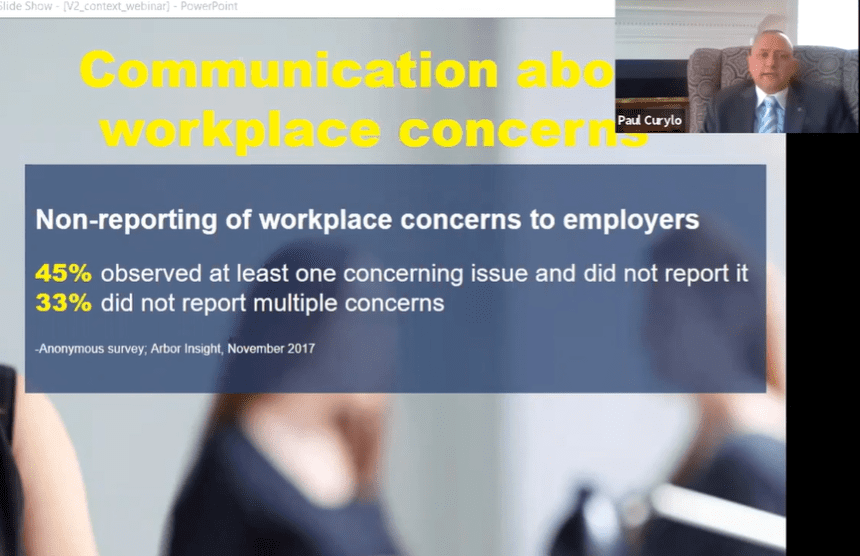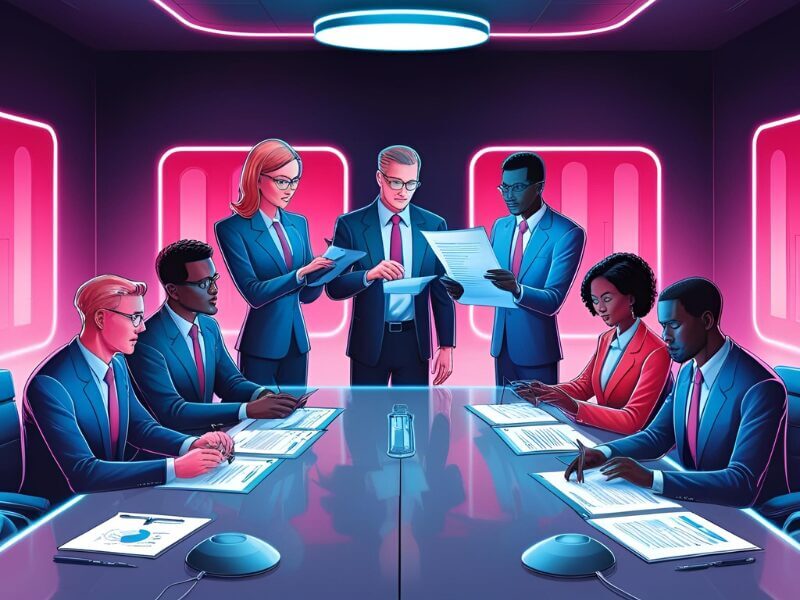Webinar: Creating Context: How to Cultivate a More Effective Intake Process


Transcript for Creating Context: How to Cultivate a More Effective Intake Process
Giovanni Gallo: Hi, everybody. Welcome to the webinar today. We’re gonna wait just a minute or so to let everyone get into the room. While we’re doing that, why don’t we take a quick roll call? Scott, where are you calling in from today?
Scott LaVictor: Well, I’m based in Ann Arbor, but today I’m sitting in the southeast corner of Charlotte.
Giovanni: All right. Welcome. And how about you, Paul? Where are you coming from?
Paul Curylo: I’m coming from Northern Virginia from between Hillsboro and Purcellville.
Giovanni: Awesome. So we’ll just wait a few more seconds, let everyone get in here. All right. Well, let’s get it started.
Scott: And…Gio, where…?
Giovanni: Go ahead, Scott.
Scott: I was just saying where are you staying.
Giovanni: Oh, yeah, I guess I should go too. I’m also in Charlotte, North Carolina. So let’s get started. Welcome to our webinar today, everyone. We’re gonna be talking about intelligent report intake and how we can cultivate a more effective impersonal reporting process. So, you know, I imagine everyone on the call has some type of intake that you do, but we’re gonna be talking about impersonal but intelligent intake. We got some great topics lined up for you, and we got a really great panel, so let’s introduce them briefly. I’m Giovanni Gallo, co-CEO of ComplianceLine. We provide report intake, case management, and other compliance services, and we’re here to make the world a better workplace.
So I am proud to introduce, in case you haven’t met him before, Scott LaVictor. So, Scott conducted investigations in intelligence operations for 13 years with the Central Intelligence Agency. And he was a manager of investigations for a Fortune 150 manufacturer before founding Arbor Insight and developing this human as a sensor reporting software solution…Welcome to the webinar today, Scott.
Scott: Thanks, Gio. Excited to be part of the ComplianceLine team to bring with me the subject matter expertise and technology that’s going to really take service in terms of intake to the next level. So, excited to talk about this today.
Giovanni: Yeah. I am too, and we’re glad to have you, Scott. And, finally, I wanna introduce Paul Curylo. Paul has performed military intelligence operations and prepared interpreters and interrogators over the past 30 years. So, Paul has trained cyber investigators, and he continues to oversee cyber and information security within the healthcare industry. He’s a real subject matter expert on a lot of things around intake, and interview, and investigation. So we’re real excited to have you on, Paul. Welcome to the webinar today.
Paul: Thank you. Very happy to be here, and looking forward to a dynamic discussion today.
Giovanni: Yeah. We’re about to have it. So, I’m gonna go over just a little bit of housekeeping, and then I’ll hand it over to you in just a second, Scott. So, we’re real glad that you came on this webinar today. We do these because we wanna add value to your life, to your profession, and help you serve your team better. So we wanna encourage you to jump in on the chat. Please, you know, add things on the chat if you have questions, if you have comments. We’ll be monitoring it throughout the presentation and discussion just in case something is really on topic, and then we’ll leave some time at the end to do a little Q&A so we can answer the questions that you have.
We really encourage you to try to make this as interactive and conversational as possible because we wanna make sure that we’re talking about the things that are gonna help you most. So, after this, we’ll follow up with you and see if there are any questions that we can ask. There are gonna be some CEU credits and stuff like that. But, without further ado, let’s jump into it, and let’s get it going. Scott, take it away, man.
Scott: Yeah. So, Gio, I think the first thing we wanted to talk about on our agenda today is that move to a digital-first workplace, you go ahead move the slide ahead, Kate, and what that means. You know, I think before COVID, we already saw an acceleration into the digital-first workplace where we saw apps, artificial intelligence, machine intelligence really starting to augment workforce in a meaningful way. And that, obviously, has only been accelerated by COVID. For example, in the insurance sector, I think they estimate it’s moved the industry forward several years just in the past several months.
And then you think about, you know, the remote workplace that we’re dealing with, that was a thing before COVID. It’s obviously a thing for us all now, and it’s gonna continue to be a thing. And so bringing into the workforce, into the workplace, especially in the context of compliance and ethics, those digital-first mindsets in terms of creating conversation is important. And last but not least, obviously, the tech landscape is evolving rapidly to provide even more opportunities for staff augmentation and increasing that dialog between compliance, ethics, risk managers, other stakeholders who are part of managing the risk in reputation of an organization as well as health and safety.
Over to you, Paul.
Paul: Yes. So, you know, in terms of the digital workplace, you know, we’ve seen a tremendous transformation in just the last year. And where the initial focus was just get things up and running, we have to continue to do work, have to continue to do business, now we’re at that point where we’re trying to reach that steady state. So, folks are going to continue in the digital space, digital-first. We had challenges before collecting and eliciting information from team members, employees to help understand problems within our environment, whether they’re compliance or ethics-related or not. So, that is somewhat exacerbated now because what used to happen by word of mouth, shoulder taps, doesn’t happen as much. We are now a near fully virtual workforce. So, providing avenues for collecting and synthesizing the information necessary for conducting the cases, case conduct, is, I think, gonna be particularly important.
Giovanni: Yeah. So, thanks, guys. Thanks for opening this up and just kinda setting the stage a little bit. So let’s get into this a little bit and talk about some of the challenges, right? Because this is kind of a moving target. This is something that’s changing because of COVID. It’s changing because of generations moving through the workplace. It’s also changing because of the digital technology that’s available to us. So, you know, I’d like to maybe throw this to Scott first, and then we’ll move to Paul. Scott, what do you think are some of the challenges and opportunities that you see with reporting and resolving workplace concerns as the workplace and the workforce become increasingly digital-first?
Scott: Right. So, I think, you know, focusing first on some of the challenges, you know, whether it’s forms, paper, or online, you know, telephone calls, often, they’re buried on a webpage in the ecosystem of the employer. So, I first talk about people have to first find it before they can engage with it. I think another one of the challenges that we’ll talk about repeatedly here today is the fact that, you know, we all know anecdotally, and there’s plenty of stats to back it up, that people aren’t making phone calls like they used to. Now, phone calls, as a subject matter expert, I’m impartial to because I always prefer that one-to-one conversation, and those should never go away, whether those conversations are in-person or via telephone or maybe even chat window. The reality is, you know, people aren’t making the phone calls they used to, and so we rely on that intake method and maybe an older form where we’re setting ourselves up for some problem.
And speaking of forms, you know, some of them are customizable. When we talk about customizable here can be somewhat of a red herring in certain circumstances whereby we’re talking about adding a couple of specific questions. You know, maybe adding your logo to the form, you know, that’s not customization in the way that I think about customization in terms of making a meaningful impact on the output of what that form is attempting to collect. And speaking of attempting to collect, it’s often guesswork. It’s a series of questions that you can fill in part of the form, and so you end up with this garbage in, garbage out scenario. And then…
Paul: You know, I can probably… You know, Scott, you bring up a good point there. You know, the initial contact with the person that’s doing the reporting is critically important. And, oftentimes, you’re right, it’s taking them a while to figure out how to connect in the first place, so they’re a little put-off or a little put back already. So, when they’re presented with a very generic or linear line of questions or generic form, a lot of times, the information provided is extremely general, resulting in the need to reach back out. But if this is an anonymous contact, now there’s a challenge with maintaining that anonymity. So, generally, what happens is the investigator, the case handler now has a problem. They have very general information about a problem someplace from a person who probably doesn’t want to be known just yet. So that really kind of leaves the case in a very unclear position.
Giovanni: Yeah. And sometimes I think it can cause an even bigger problem, right, when you have that vague starting point and you say, “Okay, now I know that there is something wrong somewhere. I’m responsible to do something about it, but I don’t really know where to go with it.” And I think that we’re kind of talking around, Scott brought it up directly, that thing about being customized, it’s not just putting a logo on it. Like, you know, maybe 20 years ago, it was really cool to have your logo on a web form. I mean, it’s less than table stakes at this point. What you really need to do is that to be customized to the conversation that’s going on, right?
Like, you know, without trying to disparage anyone, if I can make some assumptions about what leads us into this trap sometimes, I think there are times where we take a very us-centric, a very kind of regulatory policy-centric thing of I am a ethics leader and I need this information, so I need these questions answered. When, really, I think we can balance that with being more empathetic and thinking, “How would this person like to tell this to me?” What would it make sense to let them say first, and second, and things like that? And customizing that interview, that elicitation, to how someone wants to deliver the information is gonna get you better information and get you to the goal that you want anyways, good information upfront, a tight investigation, and a resolution.
Scott: Exactly right, Gio. Just to add up to that, this is all about reducing friction, right? Reducing, first, for the staff member who’s making a difficult decision to speak up, and we don’t have a good input there. We’re asking them irrelevant questions. We’re not considering their personas, the scenarios that they’re involved in that then we’re starting off on our…
Giovanni: Yeah.
Paul: Yeah. I can probably… You know, as a reporter, you know, if I am reporting an incident and I’m using a form, this has happened with me, oftentimes, I find that the form is very linear, and it really doesn’t allow me to express what I’m trying to say. So, I’ll either end up in the wrong bucket, which kind of puts the investigator in the wrong context who now has to re-establish rapport and rebuild the matter at hand to determine what the next steps are.
So, while forms work because they’re very fast, they work because they come from the perspective of the group, or agency, or department that’s trying to provide a service. So there’s certain things they wanna know upfront, but what gets lost is the perspective of the reporting. You know, the reporter wants to go in a different direction but can’t, so they just provide general information, which means there’s gonna be a second or third contact to develop that information.
Giovanni: Yeah, and it really breaks it down. You know, if you just think of a personal story that, you know, you’re telling your significant other or a friend, if you constantly, like, have to reroute it and tell the what before the why or the where after the how, it kinda throws you off, and you end up kind of losing your track. So let’s talk a little bit about that empathy, and let’s do a quick poll for the audience. So, Kate, can you pull up our poll here, and we’ll get it going. All right. You should see a poll pop up on your screen. I’ll read the prompt to you as you’re checking out. What are the top three methods of interpersonal communication staff use most often in your workplace? So you can select up to three of these and then hit Submit at the bottom, please. We’ll wait a little bit for people to fill that out.
Scott: And while they’re filling that out, I’ll just add, you know, close upthat topic we were talking about by mentioning that’s a constant tug of war, right? It’s that investigator, that respondent who wants to ask specific questions and a user who’s trying to provide information that’s helpful. And we’ll get into that later in terms of how we meet the team in the middle of it all.
Giovanni: Yeah. So let’s give it another minute or so, and then we’ll see what the poll results are. All right. Can we pull up the results? Let’s see what we got so far. I’ll just give that a second to process. All right. So, Scott and Paul, you guys can see these results, right? Anything surprising here?
Paul: Not really. You know, when I look at this, the everpresent tipline, now the question really is, you know, that phone call, is that a tipline to a voicemail, is it a tipline to a transcribing service that drops it into an application, a ticketing system, or is it an actual person? A lot of companies probably start off with, “We’ll put a live person on the line. We’ll actually do the elicitation right there,” but that can be kind of expensive depending on the volume because you’re gonna want a trained person on that phone to actually collect the information. So, yeah, that’s not very surprising.
Giovanni: Yeah. I think probably to that point that you brought up, probably the worst thing you can do is put an untrained person on the other side of the phone who doesn’t know about these issues, you know, is just kind of asking some wrote questions, and doesn’t even know if the question’s been answered but just says, “Okay, I took some notes, and I’ll move on.” You know, I think that might be even worse than a voicemail or a transcription where you at least get all of it, but, yeah, that phone call is still prevalent. And, you know, I think we’re seeing here texting…you know, texting I think is higher now than it would’ve been five years ago. We’ve seen a lot of that advancing and people working that into their intake process.
Scott: And I’d add to that that, you know, once we do add mobile apps into the ecosystem, which is relatively infrequent currently, those numbers are gonna start shifting around too. So, some interesting optics there that are, again, not terribly surprising.
Giovanni: Yeah. But, you know, hopefully, this gives you a sense of, you know, kinda where you fall in the mix. And, you know, this is gonna be different across size of company, across industry and culture, and, certainly, across kind of the age of your workforce. So, thank you, everyone, for participating in that poll. Let’s talk about some digital trends next.
Go to the next slide, please. Yeah. So, I think it’s no surprise to anybody maybe bring your own device or kind of using your mobile phone for work was surprising 5 or 10 years ago, but 90% of full-time American workers use their personal smartphones for work. So, everything’s bleeding together these days. You get emails at night, you get Slack messages in the morning. You’re on your phone in a meeting, but you see an email pop up or a calendar reminder, and then you go… You know, this device has kind of interspersed its way into our whole lives, and work is no different. So phones and smartphones are ever more prevalent. Next slide, please.
And Americans, 55 and under, use phones for email and texting at least as much as for making calls. So, again, may not be surprising, but we’re just trying to anchor you here to… You know, we’re gonna bring this around to doing these elicitation interviews, but, you know, this is part of your personal life, and if you think about it, it’s part of your work-life as well. So, there is some dissonance to say use your phone for everything in your personal life, texting your kids or making a phone reservation, use it for everything at work, but, oh, well, in regard to reporting compliance in ethics matters, well, we need you to do something else. That, obviously, causes some dissonance and causes some friction, and to Scott’s point, we wanna start reducing that friction. Next slide.
So, automated interviewing on mobile devices, this is what we’re moving toward. It increases respondents’ disclosure, precision, and satisfaction. So, talk to us a little bit about those three layers, Scott, because there’s a lot in each of those, but I think it’s critical for us to pick up on those and not just gloss over it.
Scott: Yeah. Thanks, Gio. An incredibly important study here, a few years old now, but we talk about disclosure, precision, and satisfaction. I can’t think of, you know, three more important metrics for a compliance in ethics reporting than making sure that people are open, that they’re exacting or specific in the details they provide, and have a great experience so that, you know, when they do make that difficult decision to speak up and share a concern about the workplace that they have a good experience doing so. So that whether it’s a follow-up conversation or a separate incident, you know, a few months down the line, they’re willing to come back to that method, come back to that experience, and raise their hand again.
Giovanni: Yeah. It’s really a very different thing because this is tethered to our body or our purse, on our desk constantly. It’s a different experience to, you know, I have to open up my computer and sign into my VPN network and then report on the internet. We can get that consistent interaction, like you said, Scott, even so far as getting people to come back to it. One more slide.
Okay. So, non-reporting of workplace concerns is the big thing here, right? So there’s part of what we’re trying to do here is when someone reports something, we wanna make sure we do something about it. But, you know, when you look at any number of studies, you’re gonna see that the way that… Like, the big gap is all the stuff that doesn’t go reported. So, you know, anywhere from 40% to 85% of issues go unreported. You know, depending on what studies you look at, in this study was 45% of people observed at least one concerning issue and didn’t report it. So, you know, some of those may have seen several of those, and there might’ve been a bunch more issues that didn’t get reported. And 33% didn’t report multiple concerns, which I think is a really interesting stat because that, to me, indicates at least some of those, probably reported ones, had a bad experience in the process. It was so clunky, and they stumbled through it, and they didn’t get a good interaction, and they said, “Okay, I’m not gonna report the next one.”
So these are the types of things that we’re trying to solve here. Let’s pull into some discussion. We’ve laid the groundwork for, you know, some of the context here. So maybe let’s start with you on this one, Paul. We’re focusing today on how to improve impersonal intake methods, but first let’s talk about some of the other pluses and minuses of existing methods such as phone hotlines, forms, and bots. We’ve kind of touched on that a little bit so far, but what comes to mind as kind of some of those pluses and minuses that maybe you want it for certain issues or you wanna avoid it in certain cases?
Paul: Yeah. I can tell you that as an investigator, I much prefer face to face. But in a lot of compliance and ethics situations, folks are concerned about standoff or anonymity. So, telephone helps, but you miss a lot. You miss the cues, you miss the microexpressions. So that limits the conversation. It limits what can be elicited during that initial contact. You know, and when we start looking at things like phone trees or forms, somebody has predetermined the course of that discussion, so that discussion is gonna stay very linear. So if somebody really had some additional information, it’s gonna be missed until that second or third contact or possibly not at all.
So, really, there needs to be a way to allow the conversation to develop. For humans, this is how we communicate, verbally with visual cues between us. So the closer we get to that, the more likely we are to get to a successful state in collecting that initial group of data to allow us to better handle these cases. Then one might argue that, well, we’ll go back in a second, or third, or fourth time and just get the information. And if your case volume is low, that’s great, or if this situation is not pressing, if it’s not urgent, that’s great. But if it turns out that that’s not the case, then you really do wanna get as much information as quickly as possible.
You know, one of the things we would do and that I impress on my investigators now is within the first 60 seconds of contact, there’s some very specific information you need to get. And you need to get there, or you risk the likelihood of extending or possibly ruining the case going forward. So, yeah, I would say that getting to a place where we can provide the free flow of information in as flexible a manner as possible in the context of the reporter though, not the context of the investigator or the call-taker.
Giovanni: Yeah. You gotta optimize around that because that’s where the information is coming from. And I think you bring up a great…you know, this dimension of time is both the time that an issue is sitting out there that it’s unaddressed and also how much time you have as a team to follow up on this, right? If you had infinite time, you could ask all the questions and follow up, but, you know, we’re all understaffed, and overworked, and there’s a lot of stuff going on. If you can get some efficiency, you can solve some of those time issues on both fronts. Scott, anything you wanna add to this?
Scott: No. I think, you know, as noted earlier, it’s gonna be a constant tug of war, right? You know, it’s not just about what the users wanna say, it’s about what you need to know. And so guiding that conversation in a way that makes sense to that persona. So it takes into consideration the user’s persona, the user’s experience, the user’s situation in the workplace and in the workforce is gonna help make sure that that guided interaction that’s necessarily going to occur in an in-person interaction meets up at some point with…in terms of an experience that meets both the demands of the user and of the investigator.
Giovanni: Yeah. Thanks for that, Scott. So let’s stay with you for this one. Scott, tell me your thoughts on the relationship between these three things, time-efficient investigations, the effort needed to get to the resolution of issues or incidents, and the effectiveness of this interpersonal or potentially impersonal report intake method.
Scott: Yeah. So, it all begins with intake. As Paul was noting, you know, we, as investigators and responders, would love that kickoff of that response or investigative process to be in person or at least on a telephone call. And as we’ve discussed and we’ll discuss further, those opportunities are winning significantly, and so we have to appreciate that and work within that context. So, for me, to kick off an investigation, first, I need timely information, right? I need to know that that’s happening before it gets really bad. That obviously cuts down in the scope of the investigation context.
Contextual details are important to driving an efficient resolution and investigation process. So that initial intake needs to have contextual detail, not just, you know, basics, right? And allowing for that follow-up that Paul has rightly referred to on many occasions, even when people are anonymous is important here. So, that initial intake is vital, that timely intake is vital, capturing that contextual detail is vital to the investigative planning and the execution of that response process and getting to a resolution efficiently, and with, frankly, as little time and effort as possible to reach that effective resolution because we’ve got other things to do with our day.
Giovanni: Yeah. So I’m gonna throw another one up to you, Paul, and keep it moving here. How or why is improving impersonal report intake, how is that important to staff members or the general workforce? What do you think, Paul?
Paul: Well, you know, there’s three aspects to explore there. There’s from, again, the reporter’s perspective, the reporter’s context. If I’m going to engage and share information where I’m worried about attribution or repercussions, I wanna know that I can do that confidently. And if I’m at all uncertain about that, then I’m probably not likely to report at all, which accounts for the large number of cases that go unreported. So, building the confidence in an intake method that allows a person to be able to express that information is important. But right along with that, it is also equally important to ensure that during that contact, the person through elicitation is guided to providing the information needed to actually address the matter. You know, a lot of times, the responder may get it. They already may know and have a very clear vision of what is needed. And that’s great, but there are plenty of times where that’s just simply not the case. You know, “I think I saw something,” “I’m really not sure,” “I don’t wanna get involved,” that’s where elicitation techniques are really important to help bolster confidence in the first reporting to continue to provide the details that they’ve observed or that they know about.
Now, from the context of the department that has to handle these, you know, these are important. These are important matters. When we start with just a general description of a call that was taken, there usually is not enough information there to even classify what the concern is, so there is a second contact that’s necessary. And if the person wanted to remain anonymous, now there’s the problem of, well, how do we get in touch with that person again? So, I would say that the intake process necessarily needs to facilitate the dynamism of that initial contact while also bolstering the confidence in the reporter so that they’re comfortable in providing the information that they have to share.
Giovanni: That’s an awesome way to put it. I love it, Paul. You gotta support that dynamism, and you also gotta support making them comfortable. And that’s really what we’re trying to balance here, kind of the bridge of the…you know, the personal side of it, and then the effectiveness and efficiency we get from technology. So, let’s kind of wrap this up. We’re gonna move to a poll in a second, but let’s… I wanna show you this infographic, and then I’ll give it to you, Scott, to kind of wrap it up as we go into the poll.
So, you know, this point about reporting job-related sexual harassment is really a big thing. This is only one of the topics or, you know, really, like, the categories that you get reported on, but it’s obviously important. It’s obviously terrible when it happens. And just take a look at this. I’ll just highlight some of this stuff. In the bottom left here, 85% responded that the availability of impersonal reporting was an important factor. At the top, that line of people, 80% said concerns about anonymity, retaliation, and accessibility of their reporting tool or accessibility of a trusted manager were very important factors. And then, you know, you see some stats here about how likely they were to report.
Scott, anything you wanna…? So, here, let’s do this. Kate, if you can pull the poll, we’ll get that going. People can read that. And Scott, give us some voice-over on either this infographic or the question that we sent to Paul which was, you know, why or how improving this impersonal report intake is important.
Scott: Yeah. I think, you know, to sum it up, and there’s another slide right after this, Kate, that really brings it home in terms of the workforce preference for how to report, but look at this. I mean, we talked earlier in that initial poll about how people currently communicate. Well, when you introduce a guided third-party intelligent intake app, these numbers change dramatically, and I would argue that’s pretty straightforward. They haven’t had the option to use the type of tool that they use most often in their everyday personal life, and once you introduce that, well, that changes the equation. And I would argue that it also will improve not only the volume but the quality of the report you get on these critical workplace issues. And, by the way, this is a statistically significant survey or poll on people who had experienced already workplace sexual harassment, so this carries a lot of weight from my optic here.
Paul: You know…
Giovanni: Yeah, just as… Oh, go ahead, Paul, please.
Paul: I was just gonna add, there is another aspect here to consider. When taking information in, especially for the first time, you’re relying pretty much on the full experience of the call-taker to be able to collect all the right information at the right time. Now, if you’re using a call tree or you’re using a form, you’re counting on the work of whoever put that information together to have actually covered all of your use cases and the particular branches and sequels for each of those lines of questions or components of the matter at hand. If you’re using a dynamic approach, there is the benefit of relying on subject-matter expertise to actually train the model that would provide the elicitation to collect the information, and that is pretty powerful. We’ve seen the use of machine learning and artificial intelligence algorithms in being able to pull together information in a manner that allows it to be much, much more useful. The same is true in this kind of environment.
Giovanni: Yeah. That’s great. Thank you for that, Paul. It really is key. Let’s pull up the results here. All right. Okay. Good. If this was the opposite, I’d be very concerned about our audience today. So, you know, we virtually all agree that improving staff reporting of concerns that save you time and effort and managing compliance risk and investigations is very important. And, you know, I just wanna bring it back to this point about, you know, we’ve been talking about the stats around sexual harassment, it’s very easy for us to get caught up, and, you know, many times likely so in the efficiency of it. We have to get the work done, we have to hit our stats, I wanna hit my benchmarks. But, obviously, we’re all doing this because we care about the result of it.
So, you know, this first stat on 70%, that basically means that in a year, you know, without the approach that we’re talking about, if you got five reports about sexual harassment, there’s more than three other reports out there where someone was abused, someone was harassed, and you didn’t even hear about it. So, you know, those are three people who continue to suffer, maybe, you know, have to leave their job or something like that. There’s a real cost to human life here to the anxiety and the anguish and, really, people’s livelihood when we don’t get this right. And sexual harassment is just one of the many issues where that is. This isn’t just a corporate issue. This is a personal issue for all the people who are contributing to your mission every day.
So, thanks for that. Thank you, everyone, for participating in that poll. So, I wanna jump into, you know, let’s get into the why. So let’s move to the next slide, and, you know, what we wanna talk about is the why behind this intelligent intake. So, you know, someone who is on this webinar is gonna improve their impersonal intake methods to keep pace with the changes in the workplace, changes in the workforce, and changes in the technology landscape, what are the important factors to consider, Scott? I feel like you should start us out on this one.
Scott: Yeah. So, I appreciate that, Gio. And I think we’ve pretty much laid the groundwork for that, right? So, by this point, you know, I think we appreciate the benchmarks, in terms of workforce reporting and reporting methodologies, haven’t included apps, let alone an intelligent intake app or form. And, you know, we’ve talked already about how people are using mobile apps more than phone calls. We talked about the importance of people reporting, and we generally agree to that. We’ve talked about remote workforce. And, you know, I’d add maybe setting here, you know, whether, you know, that’s gonna have an impact on, you know, office, factory, people are traveling, working from home. So, accessibility is important here.
But in terms of evaluating your method, if you’re not keeping up with the digital workforce generation and the changes in the digital workplace experience, the reckoning is coming, folks. And your fancy dashboard in the metrics are all gonna be starving for data and fuel, and you’re gonna be painting an inaccurate picture of what’s going on, and none of us wants that to happen. So, that’s kind of my hot take on that, yeah.
Giovanni: Yeah. Thanks. So, we’re gonna jump to you next, Paul, but, you know, you make a great point, Scott. You know, we need to consider these various factors. And we’re all knowledge workers, okay? Like, we use our brains, we use our minds to impact the world and impact the lives of the people we serve. And within that, we’re living in a garbage in, garbage out environment. So if you get those five reports and you’re missing those three, well then you got some blind spots, and, you know, that’s all around us.
And so we always need to be in this continuous improvement mentality of, okay, this is what we’re doing. This is, you know, fine, good enough, we’re getting by. Let’s get better. And I think you wanna think about the culture at your organization. You wanna think about the resources you have, what software platform you have, what budget you have, I mean, ultimately, the demographics of your workforce. So, Paul, as a SME, as a subject-matter expert, more specifically, given all of this that we’ve already discussed, how does a subject-matter expert such as yourself who is so deeply steeped in this interview process, you’ve trained people on it, you’ve been world-classing this for decades, how do you approach this need for us generally as a society? As ethics experts, how do you approach the need to improve outcomes via impersonal reporting intake?
Paul: Well, you know, this all gets back to your initial contact development of concise and effective questioning plans to understand where you need to take the conversation. The intake process helps with that piece. You know, we still have investigations in the cyberspace investigations where we get initial reports, and we’re not able to take them much further because we’re not able to get any additional information, we can’t make contact with the person who initially provided the information, so we end up with an unresolvable situation. Folks look at that and say, “No, we have to resolve that. There could be a real concern there.” Yes, we understand that, but we lack the information and don’t have a way to get it.
So, ensuring that we’re able to get that information on the first contact and every contact after that, guiding us into a good case collection case management is really important. When it comes to determining the truth of a matter, you really need that extra help to kind of guide you on that journey. You know, even some of my younger investigators, when they develop their questioning plan or their line of questioning, they tend to forget things, so now they’ve got to go back and get more information.
So, the enhancement of collecting that information can come through guided elicitation, and I really do think that’s particularly important. You know, some might see it as a crutch, “No, no, you need to have trained investigators.” I don’t see it that way. I see it as helping the investigator be much more effective at the job that we’ve asked them to do. And, ultimately, that leads to better outcomes, better resolutions, which, of course, feeds that all-important, that almighty dashboard so that we have a better view on what’s going on in our environment.
Giovanni: Great. Thank you, Paul. So, Scott, you know, we’ve been setting this up. We’ve been talking about, you know, what the challenges are, what the current state of the environment of the workforce is. How would a more intelligent intake process work? It’s not gonna be just a web form. Let’s do more questions and let’s, you know, have more dropdowns. We wanna be more intelligent, not just do more. So how would that work, Scott?
Scott: Yeah. So if we’re a workplace and a compliance or ethics officer who wants to hear the voice of the workforce, if we’re interested in efficient resolution, if we know that the workforce generation is moving forward and we wanna keep up with them, and if we concerned that reporting is stagnant or decreasing for reasons that relate to friction, then we need to consider this intelligent intake process. And so what first we need is we need expert-driven interviews. What I mean by expert-driven interviews are the people who are conducting elicitation interviews. They’re trained, experienced elicitation interviewers. We’re not talking here about interrogations. We’re not police officers, right? We’re trying to get those people, often who are on the margin of deciding whether or not to report in the first place, to speak up and guide them through a comfortable, relevant series of questions geared to their concern, get them in through the interaction and off the device quickly.
So the second thing is we have to have the toolset to do that and make sure that that toolset fits the problem, not the other way around. We’re not taking artificial intelligence, or machine intelligence, or natural language processing and just throwing it at the problem. We’re having a thoughtful interaction with technology and saying how can it augment our desired outcome. We’re not starting with the technology and then finding a problem. We’re having a problem and thoughtfully designing around it with the evolution of the technology landscape and making sure that that is informed with subject matter expertise is key. So those are some of the key components, I think, of an intelligent intake process without getting too specific. Paul, how would you act to that?
Paul: Yeah. You know, again, it’s around capturing the experience of folks that have done this for a considerable period of time and allowing that to guide the process. It’s like having multiple investigators on the call or on the initial contact with the reporter to help get the information necessary for a successful outcome, and I see that as a force multiplier for successful outcomes.
Giovanni: Yeah. It really has an opportunity to get better intake on the front end, get better information in the middle of it, and then get better investigations, resolutions, fixing things within the organization as that fully runs its course. And Scott, I think you bring up a key distinction here about this expert-driven interviews, right? This is not just some code jockeys banging away on a keyboard saying, “Hey, what if we put a bubble next to this thing so it looked like a chatbot? So that would be really cool, and maybe we’re gonna get better information.” You’re talking about referencing experts who have thousands, maybe tens of thousands of hours of experience doing these interviews, asking these questions, seeing how… Like, I think a key part of the expert-driven process is they’ve done this in real life. It isn’t someone kind of sitting in a room surrounded by whiteboards saying, “Hey, what if we ask this, and this, and this? It’d be great if we got all that information.” Well, you know what? In the real world, you don’t get the answers to all your questions the way that you ask them.
And I think experts in elicitation, they understand that you need to ask this question this way. You need to ask these things in this order. You need to give someone room to say whatever they want, or you need to have them pick, has it been a week, or a month, or a year, or whatever. And I think that that expert-driven piece of this is really a big game-changer to this approach of intelligent intake. This is not just technology intake where, hey, look, the same thing that we’ve been forcing people to stumble through on the hotline for 20 years, now we just put that into a web form. This is about getting smarter, this is about being more intelligent, and this is about people who have actual insights from real-world experience sitting across from somebody in an interview saying, “Hey, this is the tried and true way to deliver an elicitation interview for this category, for this subcategory, for this individual topic.” Am I getting that right, Scott?
Scott: Absolutely. We talk about the right order and the right question at the right time. How I ask a question is gonna depend on the scenario. It’s gonna depend upon the persona. It’s gonna depend on any number of things. So the wording I choose, the words I choose, the order I ask questions is all tied to the persona in this scenario. And that’s why we talk so much about putting the user first because if we’re meeting them halfway and eliciting from them details that they might not know is important, then we’re winning at the elicitation interview.
And I may be getting ahead of myself here, Gio, but, you know, this intake process, not only does it have to be grounded in subject-matter expertise with people like Paul and myself who’ve gone out there and done this in corporation settings, in cyber settings, and in warzones, you name it, but it has to be extensible. We have to be able to follow the risk, follow changes in the workplace environment, follow changes in culture, and do that efficiently and effectively over time. Not just update once a year but be able to embrace changes in demographics and issues and apply that same grouping of subject-matter experts’, you know, several hundred years of investigative experience towards coming up with that one best interview at that time, and then be able to massage that and add to it is, I think, the key factor to consider here.
Giovanni: Yeah. And the nice thing when you do that, and I wanna get your perspective on this expert piece of it, Paul, because I think that this is the big takeaway at least for me from this session today is that having an expert-guided interview is gonna solve a bunch of these other problems. It’s not just about the technology. The app is great, the smartphone is great, all of that, but having something that’s guided by experts, it really solves a bunch of these problems.
And Scott, I think, you know, you were astute to bring this up. You know, you were talking about how this can improve things for the team, for the compliance team. And what’s nice is when you have an intelligent solution like this, you’re definitely not just relying on some vendor who was maybe started by some venture capitalist who thought they could make some money off of compliance, right? You’re not just relying on your vendor, “Hey, what question should I ask,” and you’re not relying on your team who… Listen, you probably got great, smart people on your team. They probably care. They’re probably trying to change the world for the better, but they may not have 40,000 hours of interviewing people. So you can rely on, you know, better than your better, even better than what you have on your team to get these experts involved in this elicitation process, involved in this intake process, and also do it in a frictionless way over an app digitally and stuff like that. Paul, do you have anything to add about the importance of having an interview, you know, done by an expert versus, you know, kind of a newbie?
Paul: Yeah. You know, ideally, you’d want an expert on every interview on every intake, right? I mean, that would be great. That’s also not likely gonna happen. But, importantly, it’s not just having… The person who has done this the most, the expert, understands the need to, perhaps, choose the line of questioning, perhaps ask confirming questions. That’s all part of the elicitation technique, and that’s not gonna be…you can’t build that into a form. And if you’ve got a junior person taking phone calls, it’s unlikely they’re going to be able to catch those kind of situations.
So, even if you get all or most of the information, there’s still the question of, “Gee, is this really the right information?” You have to go back and ask more questions and actually confirm the information that we’ve collected. So, ensuring that we have subject matter experts involved in guiding the process, in guiding the algorithms, training the machine, if you will, I think is particularly important because, you know, each investigator will bring a different style. That culmination of styles helps us understand and leads to actually collecting and confirming the information that we expect to capture.
Giovanni: Yeah. It’s really huge. And, you know, if you’re watching this today and you can agree with me that intake for compliance and ethics is both important and it’s also complex, then I think you’ll agree with me that doing it well is going to make a difference. Arguably, something on the other end of the spectrum, I had a package that was supposed to be delivered, and it wasn’t picked up. And I can call UPS, or FedEx, or your favorite mail carrier and say, “Hey, what happened to it?” They say, “Oh, I don’t know. It wasn’t delivered. Here’s the updated information.” That’s something that’s, like, it’s maybe not that important. Like, it’s not life and death, although I do want my package, and it’s not that complex. It’s just, like, “Oh, here’s where it is on the map. It’s coming tomorrow,” or whatever. That’s something that’s easy to just dump into a dumb form, and there’s plenty of examples of that kind of, like, not important, not complex stuff.
We’re way on the other end of the spectrum where it is important. If we mess it up, your team gets way down. Risks stand out there longer, maybe someone’s life is ruined, and it’s complex to kinda get it done. So, you know, that’s why we’re talking about this, and that’s why we wanna encourage you to really step into this and, you know, see how you can leverage experts to get a better interview done. So, we got a question from the crowd, and, you know, we’re doing it for the fans. So we’re gonna pause for a second and give people some tips. It’s related to what we’re talking about. They asked, “What are the biggest mistakes that you see people make with their interviewing?” Let’s talk about where this kinda goes off the rails and where maybe, you know, people should look out for kinda sharpening things up. Paul?
Paul: Yeah. You know, number one, leading questions. If we upset the context of the reporter and start to ask them leading questions, it’s gonna take a lot to repair that and ensure that information that we collected wasn’t adversely affected by the interviewee’s or the investigator’s biases. So, I would say that’s probably my number one concern.
Giovanni: Okay. You got a quick one for us, Scott? We got a few things to move through.
Scott: No. I couldn’t agree more with that, and I’ll come back to an analogy later, but…next question.
Giovanni: Yeah. So, Scott, we’re gonna kinda do double duty real quick. I’d like to pull the poll question up in a second, so get ready for us, Kate. But, Scott, I’d like you to summarize how intelligent impersonal intake helps compliance officers save time and effort while improving staff morale. How does that all work, and walk us through that, please? And if we got a slide for this, please let us do it.
Scott: Right, right. So I think we’ll start with where he left off because then it gets incredibly important. It’s something the industry at large has really left behind, and that’s staff morale and that staff user experience is speaking up. You know, for too long, the industry’s been focused on a great dashboard, some e-learning or awareness materials that go with it, and then, oh, yeah, we gotta work on the intake method too, and I think that’s fundamentally backwards. We have to open up the funnel. We have to listen to the voices, but we don’t wanna just haphazardly open that funnel up. We need to do it in an effective way. And that’s where the intelligent intake comes in.
So we’re talking about more timely responses because we’re giving them the user experience that they’re accustomed to and prefer in terms of the method of communication. We’re guiding them through an expert interview. So, you’re answering relevant questions that are key to their issues that we can update, by the way. And then we’re giving, as a result, our clients the relevant, actionable, contextual detail they need to kick off an efficient, in terms of time and effort, and, perhaps, cost-saving response and resolution process.
Giovanni: That’s awesome. Thanks for that, Scott. So let’s pull up the poll, and then, you know, I’d invite you to weigh in on that while this poll is running. But, yeah, Scott you talked about how you can make an impact in all these different areas, right? You can make an impact on how your investigations are done. You can make an impact on how the resolutions go. You can make an impact on how people view HR and compliance, not as this distant kind of unrelated, kind of out-of-touch team and division but really someone who kinda gets it, is cutting-edge, and is giving people what they need so they can jump into it. So, Paul, do you have any perspective on that on how this can change the tide and kind of have a different type of interaction, especially as related to improving staff morale while saving time and effort?
Paul: Well, you know, folks are very concerned about their time. Time is gold to folks. So if they’ve taken the time to engage and report an issue, we have to demonstrate that we respect that. That helps with some of that rapport. So, being very efficient and very focused on the types of questions that get asked to collect that information, that’s particularly important. I would say, you know, if that point is belabored, then away goes that reporter. They’re just gonna drift away from us.
Giovanni: That’s awesome, Paul. Thanks for doing that. So, you know, we have some things on the slide here, kind of the difference between static forms and a digitized intelligent interview. So we’ve talked about a bunch of these, but, you know, it’s kind of just asking some simple questions or asking contextual but not leading questions that lead someone to convey this. So, Scott, why don’t you wrap us up? We’ve got a few minutes left. Why don’t you take us through an impact example and, like, tell us how this scenario would work in an intelligent intake situation.
Scott: Right. And so, you know, when I built the software is because of personal pain points, right? So, it’s the workplace violence scenario where, you know, somebody didn’t wanna make the phone call to share the fact that the arguments have gotten so bad or become so bad that somebody had brought a gun to the office. And when I finally spoke to that person, I said, “Well, why didn’t you share this?” Well, I didn’t wanna make a phone call because I didn’t feel it was anonymous.
Or in the case of…I did a lot of theft of devices that had confidential information on them. You know, asking those follow-up questions that are key to that scenario. You know, was it encrypted? Who used the computer? The order in which you ask these questions, as well as the content, is gonna be, in this case, extremely impactful on… You know, is it just encrypted or the device that was used once or twice, or is it a device that has intellectual property, customer list, etc., is unencrypted, and is now sitting in an airport in China? So, just example after example of where those contextual non-leading questions are gonna result in a better outcome for all concerned.
Giovanni: Yeah. That’s awesome, Scott. Thanks for bringing that up. So, you know, as we wrap it up here, we wanted this…this is not an elicitation interview, this is a webinar, right? We wanted this webinar and this panel to be about helping you kind of focus on how you can make your interviews better. We at ComplianceLine have partnered with Scott and the Arbor Insight team to bring the world this artificial intelligence expert-trained digital reporting intake elicitation process. Our Intelligent Intake App is going to allow you to get all of the things that we’ve talked about today.
We’ve tried to focus this discussion on things that you can take to figure out how to do your investigations better, pay attention to what’s going on digitally. But if you’re interested in learning more, go to bit.ly/hotlineapp. You can email Scott. His email is right there. We’d love to show you this in real life. Listen, our intelligent intake app is the only AI-driven, expert-trained app and web app that allows you to get the benefit of all the things we’ve talked about today. It’s a mobile app, it’s digitally native, it’s expert-trained, and it’s contextualized to the actual situation that’s there. So, we’d love to offer it to you and your team. We’d love to give you a sense of how this can really change the game from that boring, staid, very stiff web form or, you know, whatever else you’ve been trying to really open up a new conversation with people in your workplace.
So that’s what we’re offering to the world. That’s how we’re trying to make the world a better workplace. So that’s what we have, but we hope that within the time that we’ve covered today, you’ve learned something about elicitation interviews, you’ve learned something about how important that is. And regardless of whether this app is right for you, we hope that it’s something that you can take to your team to make your team better. Anything you wanna wrap us up with, Scott?
Scott: Well said. If our viewers, they are interested in future-proofing their intake so that they meet the workforce where they are, improve that process of bringing in contextual actual information that leads to more timely relevant information and enclosures and resolutions of issues, we’re here for them. That’s what we’re built for. We’re built for the next generation of hotline users, frankly.
Giovanni: Yeah. That’s awesome. And as you can see here, if you book a demo soon, we’re gonna staple a coupon to that demo so that you can get a discount when you’re ready to buy it. But, you know, really, we wanted this to be something that adds value to your life and helps you serve your team better. If our app and our expert-trained interviews can help you do that, we’d love to show you. But I’ve been your host, Giovanni Gallo, co-CEO of ComplianceLine today. Paul, it’s been so great to have you, sir. It’s really great to think of all of the positive impact that you’ve had over your career, of all the interviews that you’ve done, and all the ways that you’ve made the world better. I appreciate you sharing some of that insight and that expertise with us today. It’s been a real joy to have you on.
Paul: Thank you, gentlemen. I appreciate the opportunity to share and have a frank discussion about elicitation.
Giovanni: Yeah. And thank you, Scott. I can’t tell you enough how excited I am to have you as part of the ComplianceLine and to really help launch and expand the impact of this intelligent intake app. I was blown away the first time I saw it. I continue to be impressed and excited about all the ways that intake, and interviewing, and elicitation at workplaces around the world can be better as more and more people adopt it. So, thank you, Scott, for, you know, lending your mind to this app, to lending your passion to this webinar, and I’m excited to continue to work with you to make the world a better workplace.
Scott: Looking forward to it, and couldn’t agree more. I think this is an exciting precipice of bringing the best-in-class telephone hotline intake of ComplianceLine with the best-in-class intelligent intake app. It’s a powerful force going forward. Looking forward to it.
Giovanni: All right, everyone, thank you for joining us today. I hope this was valuable to you. We’ll be following up with you with a few things, but please feel free to reach out to Scott, reach out to anyone on our team. We’re all here. We live to serve, and we wanna help you do your job better. Because we think when we can be a servant to you and you can take better care of your employees, then the world will be better, and that’s what we’re all about. Thanks for joining us today. Have a great week.





































